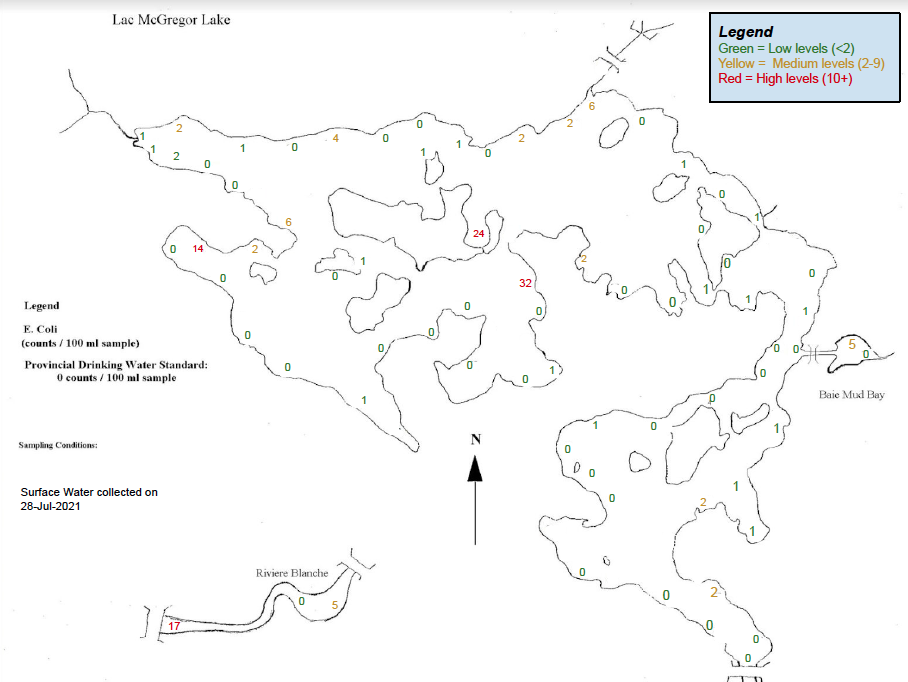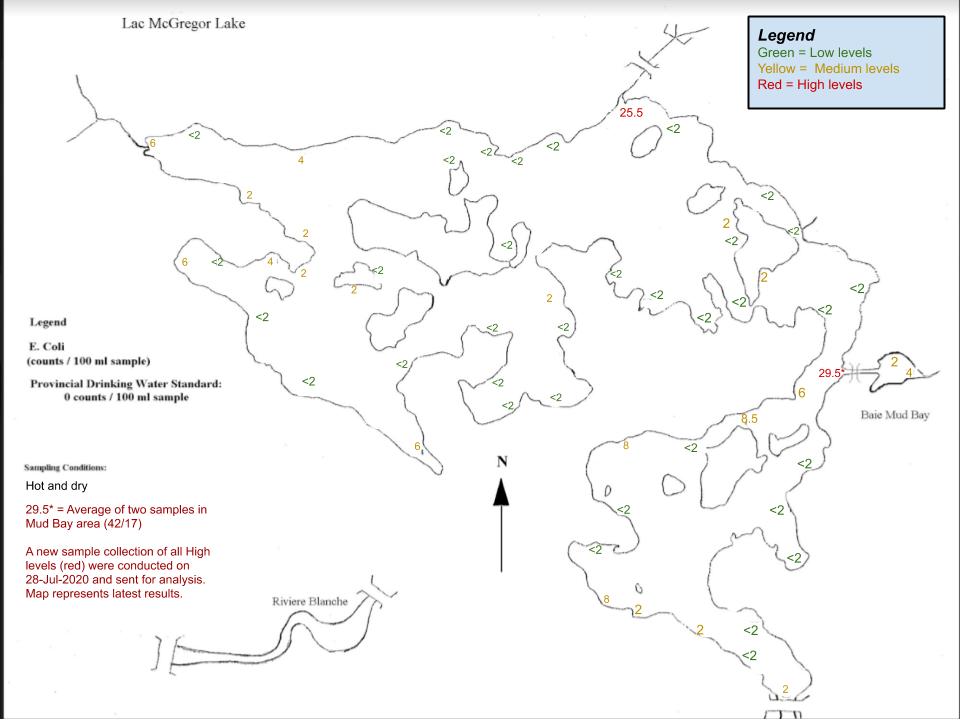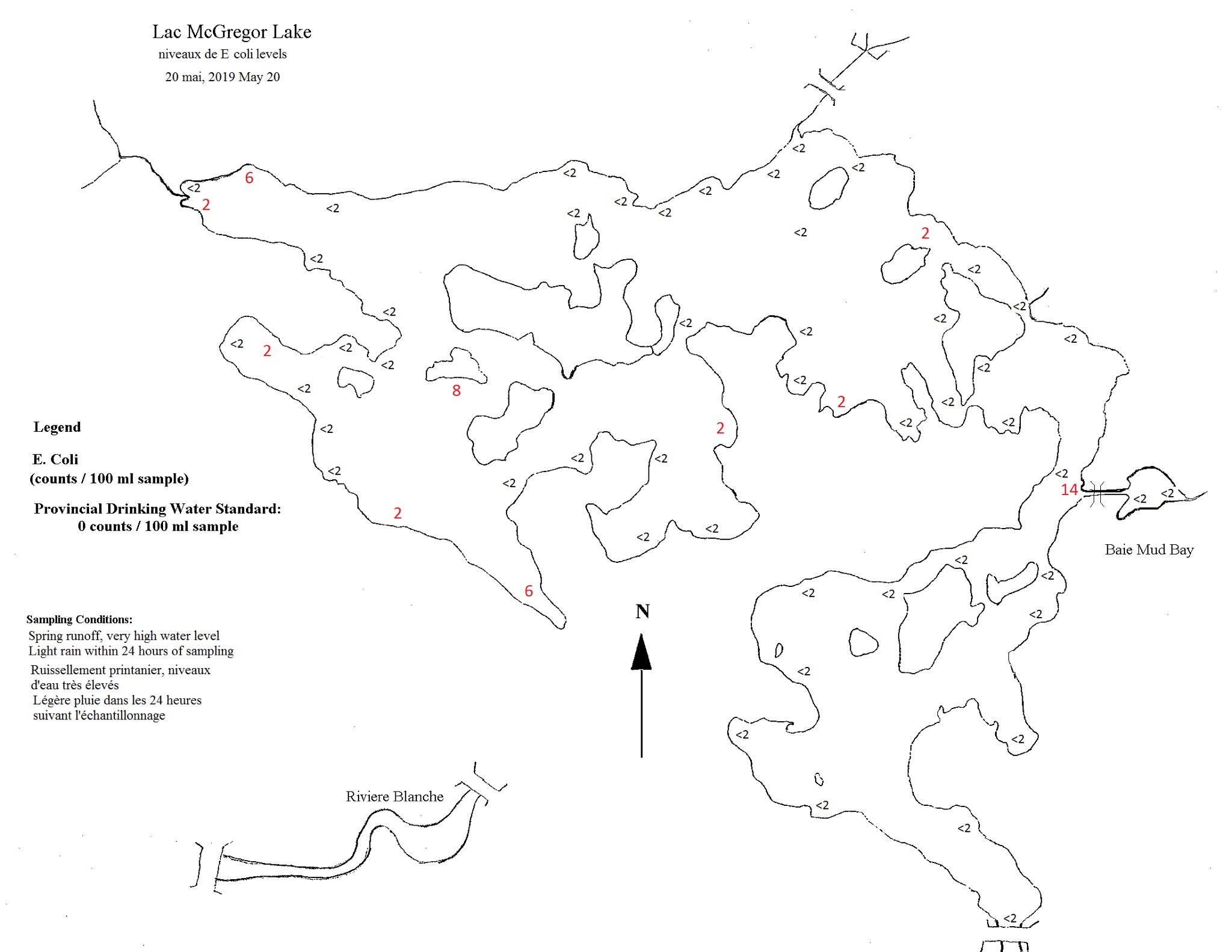~ Water Testing on McGregor Lake ~
Background
For more than 50 years, the Association has been testing surface water conditions once or twice a season for Escherichi Coli bacteria, commonly called E. coli. The results of the water quality testing for the past few years are included below.
E. coli is one of the most common species of coliform bacteria. It is a normal component of the large intestines in humans and other warm-blooded animals. It is found in human sewage in high numbers. E. coli is used as an indicator organism because it is easily cultured, and its presence in water in defined amounts indicates that sewage may be present. If sewage is present in water, other disease-causing bacteria may also be present. It is important to note that given the many factors and variables, results from one sample testing to another can vary significantly even at the same time in the same location. As such, these tests help us to monitor any changes or trends in the level of contaminants in the water over time. So far, and including this recent round of testing, our levels remain fairly good, and stable. However, some long time readers might notice that some levels in typical trouble spots are higher this year. This is likely due to the extended hot weather and increased algae and plant growth in the water.
So what causes higher levels and what does it mean? Heavy rain, spills, leaking septic systems and runoff from shorelines as well as bird and animal droppings are the most common factors that can affect bacteria levels. Acceptable levels for swimming and recreational activity are counts of less than 2. When higher levels are indicated, you could be exposed to bacteria that may cause diarrhea or infections in your ears, nose, throat, eyes and skin. We do not test for drinking water standards which are less than 1. Since all recreational waters are likely to contain some E.coli contaminants it is generally advised not to drink any lake water without an appropriate water treatment process in place.
New approach for Water Quality Testing as of Summer 2021
On March 19, 2021, the Federation of Lakes of Val-des-Monts advised the Association that the Municipality will now be conducting the water quality testing for the region’s lakes. You can read more about the approach that will be adopted by the Municipality in this document (VdM Water Testing March 2021 | VdM Analyses de l’eau Mars 2021). The Association plans to coordinate the volunteers for the Municipality’s water testing and to also continue our own specific water testing, as required. The Report on the results of the 2022 water quality (in French) provides data specific to McGregor lake. As well. data for 2023 can be found in the Water Quality Analysis Report.
In 2023, the MVDM test program included five locations on McGregor lake, the most of any of the lakes in the study. Marianne and Brennan O’Byrne conducted biweekly secchi disk readings at all five locations, throughout the summer of 2023. Huge commitment and much appreciated. Dominique Laflamme took on the task of conducting the full water sampling at three of those locations for the scheduled test dates. Again very much appreciated. And lastly our intrepid president, Natalie Lavigne stepped in when going got tough and nobody else was available. Thanks to all of you.
The Association is always looking for volunteers to help with the sampling. It only takes an hour or so and is a great way to get your kids more involved in water stewardship at the cottage! If you’re interested please send us an email at lacmcgregorlake@gmail.com and we’ll contact you when we have dates for testing next year!
Results of Water Testing conducted by MLA
August 23, 2023
The second of two sampling days for the summer of 2023 was held on August 23 when 62 sites were sampled. I want to thank all our water testing volunteers (Peter, Sylvie, Ravi, Norm, Liz, Bruce and Samantha) for their help in collecting the water samples and Rina for inputting all of the results onto the attached map.
This sampling event included all the areas that indicated any level of E-coli in the first round on July 19, 2023 and a couple of additional areas to help to pinpoint the possible location of a source. The two additional sites were just beyond the southern bridge where the lake leads into the Blanche river and just after the bridge over the creek that connects McGregor with Lac Brassard.
Both of these extra sampling sites indicate that there is a source close to those areas that needs more investigation. Additional sampling and analysis will take place in early September.
Peter Barton
Results of Water Testing conducted by MLA
July 19, 2023
The McGregor Lake Association conducted again periodic monitoring of lake surface water for the determination of levels of E coli. E coli is a bacteria that can be present in the fecal matter from animals and can cause illness in people. Elevated levels found in surface water can indicate that domestic or wild animals are defecating on or near the shore or that domestic sewage systems are not working properly.
The first of two sampling days for the summer of 2023 was held on July 19 when 58 sites were sampled. I want to thank Amy Lawes and Philippa McDonald for their help in collecting the water samples and Rina Fougere for inputting all of the results onto the attached map.
The next sampling day will be scheduled some time mid-August, and will be weather dependent. The “best practise” rule is that sampling should not be conducted if a significant rain fall has occurred within four days as shore runoff can skew the results. That being said, sampling after a rainfall can indicate areas that should be avoided for recreational activities if levels above 200 are observed. The weather forecast before the July 19th sampling was for continued unsettled weather and so the sampling was conducted after only two days with no rain. In spite of that, the levels are quite consistent with what has been reported over the past few years.
The next sampling session will include all of the sites that indicated a reading above <2 counts/100ml and those areas that were not sampled in the previous round.
Peter Barton
Results of Water Testing conducted by MLA
August 28, 2022
This year’s water sampling was carried out on Sunday August 28th. Our group of volunteers took 80 samples over the course of two hours. I want to give a shout out and sincerely thank our teams:
- Gilles Picard and Wayne MacDonald
- Jill and Steve Nimmo
- Marc Savage
- Ravi and Frances Mehta
- Sylvie Halde and crew!
- Rina Fougere (map)
- Lisa Barton (call up from the minors)
The results for the testing conducted this year indicated five areas with elevated levels of bacteria. These five areas have not been retested but will be in the normal course of the yearly testing.
It is important to note that given the many factors and variables, results from one sample testing to another can vary significantly even at the same time in the same location. As such, these tests help us to monitor any changes or trends in the level of contaminants in the water over time. So far, and including this recent round of testing, our levels remain fairly good and stable. However, some long time readers might notice that some levels in typical trouble spots are higher this year. This is likely due to the extended hot weather and increased algae and plant growth in the water.
We do not test for drinking water standards which are less than 1. Since all recreational waters are likely to contain some E.coli contaminants it is generally advised not to drink any lake water without an appropriate water treatment process in place.
We will be testing again next year and are always looking for volunteers to help with the sampling. It only takes an hour or so and is a great way to get your kids more involved in water stewardship at the cottage! If you’re interested please send us an email and we’ll contact you when we have dates for testing next year!
Peter Barton

Municipality’s water testing – McGregor Lake Results 2021
Following the adoption of the Water Management Master Plan on May 5, 2020, the Municipality of Val-des-Monts began monitoring water quality in May 2021. For the first phase of this program, 47 lakes were targeted. They were selected according to the anthropogenic forces to which they are subject. The bodies of water most likely to be subject to anthropogenic forces, for example residential development, the presence of roads and the proximity of agricultural land, were selected. In April 2021, the Municipality reached out to the lake associations and residents in order to call upon the many volunteers and enthusiasts interested in contributing to the program. The volunteers then followed a training session offered by the Municipality on the procedures governing the gathering of data, after which data collection for the 2021 season began in June.
The Municipality would like to thank all the volunteers who participated directly or indirectly in carrying out the data collection. Their great participation made it possible to carry out numerous follow-ups throughout the territory.
The water testing reports can be found in the Environnement et Urbanisme » Environnement » PDE – Suivi de la qualité de l’eau section at the following link. Note: The reports are currently only available in French. However, a Report summary in English as it concerns McGregor Lake has been added below. McGregor Lake is an integral part of the Blanche watershed. It ultimately empties into the Blanche River to the south. It is fed by several tributaries including Ruisseau Pélissier to the northwest, Lac Brassard to the north, Lac du Castor and Baie Mud to the east. Please keep in mind that the findings obtained are solely based on the data collected and represent only the situation at the time of the data collection. A continuous monitoring strategy will be required in order to establish a more assertive conclusion.
Summary of McGregor Lake Findings
(Note: This summary is only available in English. It has been added since the Full Report is only available in French)
McGregor Lake has 5 monitoring stations, 3 of which are subject to physicochemical monitoring and present very similar results and generally reach the same trophic state. The first station, MG1, has an average summer transparency of 6.5 meters. This transparency characterizes very clear water and places the state of the lake in the Oligotrophic state. The average concentration of chlorophyll A is 6.5 µg/l, which indicates water with a high biomass of algae and microscopic plants in suspension. This parameter places the lake in the Meso-eutrophic transition zone. Lastly, the average concentration of total phosphorus measured is 2.0 µg/l, which indicates that the water is very poorly enriched in nutrients. This variable indicates that the body of water is in the Ultra-oligotrophic state.
The physicochemical variables of the MG1 station present discordant signals, but the trophic state of the lake is probably in the Oligotrophic zone.
The second station on McGregor Lake, MG2, presents results very similar to those obtained at the MG1 station. The average summer transparency is 6.3 meters, the chlorophyll A concentration is 4.6 µg/l and the average total phosphorus concentration is 2.7 µg/l, which means that the water is poorly enriched and that the trophic state is generally maintained in the Oligotrophic zone.
The third station on Lake McGregor, MG3, recorded an average transparency of 5.9 meters, demonstrating an Oligo-Mesotrophic state. The chlorophyll A concentration demonstrates a Mesotrophic state with a concentration of 3.9 µg/l. Lastly, the phosphorus concentration of 3.0 µg/l demonstrates a trophic state in the Ultra-oligotrophic zone.
The physicochemical variables of the MG3 station give discordant signals, but the trophic state of the lake is probably located in the Oligo-mesotrophic transition zone or even in the Oligotrophic zone.
The two additional monitoring stations, namely MG4 and MG5, were subject only to water transparency readings and show results supporting the conclusions established above. Both stations have an average transparency of 5.7 meters characterizing the lake as Oligo-mesotrophic.
It is important to note that additional data and monitoring will be necessary in order to establish more precisely the trophic state of the lake. Additional data will aim to reduce the margin of error of the data presented in this report.
Results of Water Testing conducted by MLA
July 28, 2021
On July 28, 2021 volunteers sampled lake surface water at over 70 locations around McGregor lake. The locations were selected based on historical data, new developments, and creeks and streams that feed water into the lake.
This sampling and analysis regime is a snapshot of the health of the lake at a point in time with respect to E. Coli bacteria and can be affected by recent events such as runoff due to a recent rain, the presence of wild life including geese and beavers, or domestic animals.
Streams which have a very high ratio of shoreline to water, or shallow areas with slow moving water, generally show higher concentrations of bacteria due to some of the reasons mentioned earlier. Sampling at the outlet of a stream and then down the lake shore some distance provides some measure of how well the lake is able to manage the bacteria load from the stream.
The sampling conducted on July 28, 2021 was only one day after several days of wet weather and so should be considered as close to a worst case scenario, with the only worse case being sampling during or directly after a heavy rain storm with much more runoff water entering the lake. Given that the results indicate that there are only three or four readings that could be of concern for the nearby residents, this sampling indicates that the health of the lake is fairly good with respect to E. Coli.
July 28, 2020
July 5, 2020
May 2019
July 2018
July 2017 September 2015
September 2015
July 2015
June 2014
___________________________
Federation of Lakes Survey of Waterfront owners of Val-des-Monts
In 2015, volunteers from 23 lake areas in Val-des-Monts took part in the État de vieillissement des lacs project. The goal was to gather water samples to register each lake’s phosphorous, dissolved-organic-carbon and chlorophyll levels three times over the summer (mid-June, mid-July, and mid-August). In addition, the volunteers evaluated the water transparency at each sampling. The overall results of the survey, which will help determine the trophic status or “age” of each lake, as well as which lakes need added care, are posted on the Federation of lakes website.








